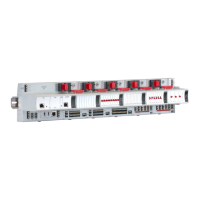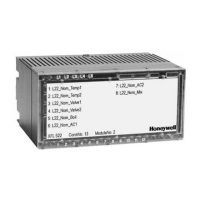ALPHABETIC REFERENCE EXCEL CARE CONTROL ICONS
74-5577–33 (US) 102
EN2B-0184 GE51 R0518 (Europe)
XFM 35 General Functions
The strategy for the maximum load optimization program (XFM 35) includes general
functions to provide stability, special features, and power control alarms . These
functions have a high priority in making the final decisions about load switching.
Functions include:
• Shed/Restore value limitation
• Start-up after a power failure (Ideal Curve and Extrapolation only)
• Parameter modification at run-time
• Freeze time function (Ideal Curve and Extrapolation only)
• Switch-on wait time
• Power limit setpoint switchover
• Switching behavior of loads in a priority group (sequential or rotational)
• Synchronization pulse loss
• Manual load shed required message
• Peak load notification (Ideal Curve and Extrapolation only)
• Shutdown of loads ((Ideal Curve and Extrapolation only)
• Totalizer input reset (Counter_Zi)
Shed/Restore Value
Limitation
(Output Po1/2/3) The selected algorithm calculates a power value to be switched by the loads.
Parameter P5 (maximum switch-on power value) limits this power value .
To avoid frequent cycling of loads, software does not transmit power values near
zero to the XFM 36-1 loads. A hysteresis parameter (P7) creates a deadband
between -P7 and +P7. A calculated power value within the deadband -P7 and +P7
sets the XFM 35 output (Po1/2/3) to zero. Outside the interval the switch-on values
are limited by P5 and then transmitted to Po1/2/3.
The following table lists the parameters used for the limitation of the power value.
Parameter
Number
Type
Brief Description
Setting
Range
Default
Value
Unit
5 Comm. Maximum Switch-on Power 1-1000 10 kW
7 Comm. Hysteresis for Power Switching 0-1000 0.5 kW
Start-up After a Power Failure
(Ideal Curve and
Extrapolation only) If a power failure occurs, XFM 35 uses the following strategy to start up the
calculations of the power values:
1. A shutdown message is sent to all the XFM 36-1 loads. They are switched off
by setting the user address ID___Shutdown to the value 1 after the power
supply returns.
2. On the next program cycle, the shutdown message is gone and XFM 35 starts
to switch on the loads with the maximum switch-on power value set in
Parameter P5 every calculation sample until a synchronization pulse is
received.
3. After receipt of this pulse, power calculations continue normally.
This start-up procedure is not valid for the sliding window algorithm. The sliding
window algorithm uses the power values that were measured before the power
failure occurred for the calculations after the power failure.

